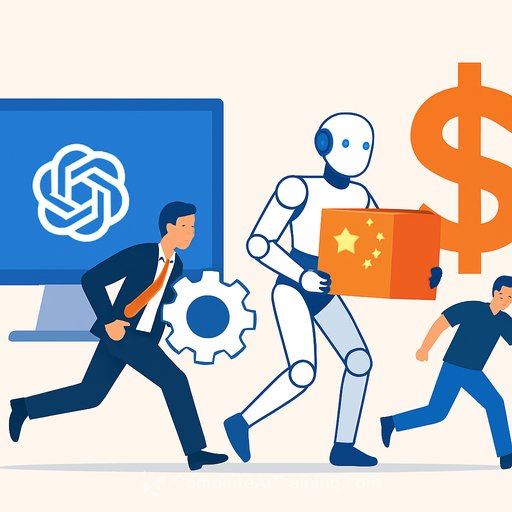Tariff shock turns urgency into orders: Chinese robotics exporter credits "sales consultant" Trump
A small Chinese robotics supplier just got what every sales team wants: a hard deadline and a financial trigger no buyer can ignore. A threat of an additional 100% tariff on all Chinese imports starting November 1 has set off a buying spree among US humanoid robot makers and AI companies - reportedly including industry leader OpenAI - to lock in components now.
MyActuator, a Suzhou-based manufacturer of intelligent drive modules for humanoid robots, received 1,000+ new orders in the last week. The message from buyers is clear: ship before the policy hits.
What's happening
- US buyers are placing emergency orders to avoid a potential 100% tariff.
- Factories in Suzhou, Dongguan, and Changzhou are running overtime to meet demand.
- The company employs 70+ staff, books roughly 50 million yuan (about US$7 million) a year, and typically handles tens of thousands of orders annually.
- This is a sharper surge than previous tariff scares, suggesting buyers believe the threat is real this time.
Context: A 100% tariff effectively doubles import cost. For procurement, that's not a minor price increase - it's a budget-buster. Deadlines like this pull forward demand.
Background on tariff actions: USTR Section 301.
Why buyers moved fast
- Hard deadline: A date forces decisions that would otherwise stall.
- Massive cost delta: A 100% swing makes "wait and see" too risky.
- Supply risk: If everyone buys at once, capacity and lead times get squeezed.
- Board visibility: Tariffs get executive attention, which accelerates approvals.
Sales takeaways you can use this week
- Lead with the math: Quantify the avoided cost. "Placing this month avoids an estimated +100% import charge post-Nov 1." Keep it short and specific.
- Create a tiered clock: Offer cutoffs tied to ship dates. Example: "Orders confirmed by [Date] ship before Nov 1. After [Date], we cannot guarantee pre-tariff delivery."
- Prioritize by impact: Segment accounts by tariff exposure and volume. Hit enterprise buyers and critical SKU customers first.
- Involve finance early: Escalate to CFO/procurement with a one-pager that compares "buy now vs. buy later" total cost.
- Secure capacity: Lock production slots and materials for committed POs. Communicate allocation rules to avoid surprises.
- Advance payments: Offer small discounts or priority allocation for deposits to speed commitments.
- Protect margins: Publish a post-deadline price policy now. "All quotes subject to revision upon tariff implementation."
- Bundle essentials: Encourage customers to consolidate SKUs and order full kits to reduce future tariff exposure and partial shortages.
- Shorten cycles: Use a 24-48 hour "confirm or release" window on tentative holds.
Messaging that moves deals forward
- Subject: Action required: secure pre-tariff pricing before Nov 1
- Body (brief): "Given the proposed 100% tariff on imports starting Nov 1, we're allocating limited pre-tariff production slots. If we confirm your PO by [Date], we can ship before the policy takes effect. After that window, pricing and lead times may change. Do you want us to reserve [Quantity] units for you now?"
- Call script (30 seconds): "I'm calling to secure your pre-tariff allocation. The proposed 100% tariff would double import cost on orders shipped after Nov 1. I can reserve [Quantity] units that ship before the deadline if we confirm by [Date]. Do you want me to lock that in?"
Operations: fulfill fast without breaking
- Freeze specs: No late changes on pre-tariff orders. Changes equal new lead times/prices.
- Capacity signals: Publish weekly available slots and cutoffs to sales so commitments stay realistic.
- Logistics lanes: Pre-book freight and diversify carriers to avoid bottlenecks at month-end.
- QC and documentation: Errors at customs will miss the tariff window. Double-check HS codes, invoices, and origin docs.
Risk management
- Inventory risk: Focus on firm POs with deposits; limit speculative builds.
- Counterparty risk: For new buyers, use escrow, letters of credit, or staged payments tied to production milestones.
- Policy risk: If implementation shifts, keep customers updated with a simple status email each Friday.
For buyers on your list (talking points)
- "This order protects your 2025 roadmap from a sudden 2x cost on critical drives."
- "We've reserved factory time in Suzhou/Dongguan/Changzhou for pre-tariff shipments - first come, first served."
- "Post-Nov 1 pricing will reflect any new import costs. Lock in now to avoid renegotiation."
What to watch
- Official tariff announcements, timelines, and exceptions.
- Port congestion and carrier capacity near month-end.
- Supplier lead times and raw material constraints as more buyers rush in.
Use the deadline. Keep the math front and center. Make it effortless to say "yes" right now.
Helpful resources
- USTR: Section 301 investigations and tariff actions
- Complete AI Training: Courses by job (build faster sales workflows with AI)
Your membership also unlocks:






